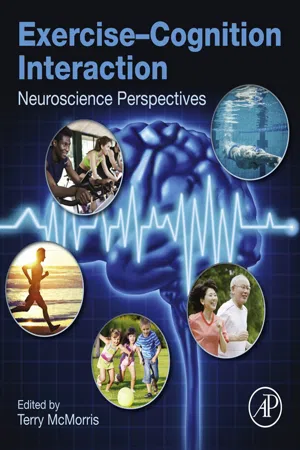
- 504 pages
- English
- ePUB (mobile friendly)
- Available on iOS & Android
About this book
Exercise-Cognition Interaction: Neuroscience Perspectives is the only book on the market that examines the neuroscientific correlation between exercise and cognitive functioning. The upsurge in research in recent years has confirmed that cognitive-psychology theory cannot account for the effects of exercise on cognition, and both acute and chronic exercise effect neurochemical and psychophysiological changes in the brain that, in turn, affect cognitive functioning.This book provides an overview of the research into these effects, from theoretical research through current studies that emphasize neuroscientific theories and rationales. It addition, users will find a thorough examination of the effects of exercise interventions on cognitive functioning in special populations, including the elderly, children, and those suffering from a variety of diseases, including schizophrenia, diabetes, and an array of neurological disorders.With contributions from leading researchers in the field, this book will be the go-to resource for neuroscientists, psychologists, medical professionals, and other researchers who need an understanding of the role exercise plays in cognitive functioning.- Provides a comprehensive account of how exercise affects brain functioning, which in turn affects cognition- Covers both theory and empirical research- Presents a thorough examination of the effects of exercise interventions on cognitive functioning in special populations, including the elderly, children, and those suffering from a variety of diseases- Examines neurochemical, psychophysiological, and genetic factors- Covers acute and chronic exercise
Frequently asked questions
- Essential is ideal for learners and professionals who enjoy exploring a wide range of subjects. Access the Essential Library with 800,000+ trusted titles and best-sellers across business, personal growth, and the humanities. Includes unlimited reading time and Standard Read Aloud voice.
- Complete: Perfect for advanced learners and researchers needing full, unrestricted access. Unlock 1.4M+ books across hundreds of subjects, including academic and specialized titles. The Complete Plan also includes advanced features like Premium Read Aloud and Research Assistant.
Please note we cannot support devices running on iOS 13 and Android 7 or earlier. Learn more about using the app.
Information
History of Research into the Acute Exercise–Cognition Interaction
A Cognitive Psychology Approach
Abstract
Keywords
Arousal; Automaticity; Cognitive–energetical theories; Inverted-U theory; Working memoryIntroduction
Development of Theoretical Rationales
Table of contents
- Cover image
- Title page
- Table of Contents
- Copyright
- Contributors
- Chapter 1. History of Research into the Acute Exercise–Cognition Interaction: A Cognitive Psychology Approach
- Chapter 2. The History of Research on Chronic Physical Activity and Cognitive Performance
- Chapter 3. Animal Models of Exercise–Brain Interactions
- Chapter 4. Beyond the Catecholamines Hypothesis for an Acute Exercise–Cognition Interaction: A Neurochemical Perspective
- Chapter 5. Acute Exercise and Event-Related Potential: Current Status and Future Prospects
- Chapter 6. Acute Exercise and Cognition: Effects of Cerebral Oxygenation and Blood Flow
- Chapter 7. The Reticular-Activating Hypofrontality (RAH) Model of Acute Exercise: Current Data and Future Perspectives
- Chapter 8. Chronic Exercise and Cognition in Humans: A Review of the Evidence for a Neurochemical Basis
- Chapter 9. The Chronic Exercise–Cognition Interaction: fMRI Research
- Chapter 10. Physical Activity, Fitness, and Cognition: Insights from Neuroelectric Studies
- Chapter 11. Effects of Athletic Fitness on the Exercise–Cognition Interaction
- Chapter 12. “Cogito ergo sum” or “ambulo ergo sum”? New Perspectives in Developmental Exercise and Cognition Research
- Chapter 13. Acute Exercise and Cognition in Children and Adolescents: The Roles of Testosterone and Cortisol
- Chapter 14. The Chronic Exercise–Cognition Interaction in Older Adults
- Chapter 15. The Chronic Exercise–Cognition Interaction and Parkinson Disease
- Chapter 16. The Chronic Exercise–Cognition Interaction and Dementia and Alzheimer’s Disease
- Chapter 17. The Chronic Exercise–Cognition Interaction and Diabetes
- Chapter 18. The Exercise–Cognition Interaction and ADHD
- Chapter 19. Cognitive Impairment in Breast Cancer Survivors: The Protective Role of Physical Activity, Cardiorespiratory Fitness, and Exercise Training
- Chapter 20. Physical Activity and Cognition in Older Adults with Heart Failure
- Chapter 21. The Effect of Regular Exercise on Cognition in Special Populations of Children: Overweight and Attention-Deficit Hyperactivity Disorder
- Chapter 22. Exercise–Cognition Interaction: State of the Art and Future Research
- Index